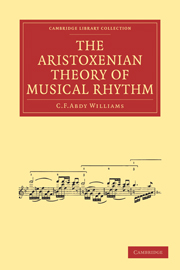Book contents
- Frontmatter
- PREFACE
- Contents
- MUSICAL ILLUSTRATIONS
- INTRODUCTION
- CHAPTER I
- CHAPTER II
- CHAPTER III
- CHAPTER IV
- CHAPTER V
- CHAPTER VI
- CHAPTER VII
- CHAPTER VIII
- CHAPTER IX
- CHAPTER X
- APPENDIX A Quotations, from original sources, of passages referred to in the text
- APPENDIX B Glossary of Technical Terms
- APPENDIX C Dactylo-epitritic, Logaœdic, and Dochmiac rhythms, and rhythmical modulation. M. Laloy's views
- INDEX
- Frontmatter
- PREFACE
- Contents
- MUSICAL ILLUSTRATIONS
- INTRODUCTION
- CHAPTER I
- CHAPTER II
- CHAPTER III
- CHAPTER IV
- CHAPTER V
- CHAPTER VI
- CHAPTER VII
- CHAPTER VIII
- CHAPTER IX
- CHAPTER X
- APPENDIX A Quotations, from original sources, of passages referred to in the text
- APPENDIX B Glossary of Technical Terms
- APPENDIX C Dactylo-epitritic, Logaœdic, and Dochmiac rhythms, and rhythmical modulation. M. Laloy's views
- INDEX
Summary
Schubert.
The genius of this composer was peculiarly sensitive to rhythmical expression, and features analogous to those of Greek music are not uncommon with him. In the first subject of the great posthumous D minor quartet, we undoubtedly have two examples of crousis, in the single foot which occurs twice over in bars 19 and 25, the bars in which the first violin and violoncello utter four crotchets on the note A. And what a deliciously fresh effect these isolated and apparently interpolated bars give, though to the superficial observer they seem to occur at random in the midst of four-bar phrases. Again, in the opening bars of the C major symphony, the unison passage for the horns is in two distinct tripodies, followed by a sort of sigh on the final dipody of the Greeklike period 3 + 3 + 2. In the Andante con moto of the Unfinished Symphony, after the introductory two feet, the melody enters on the violins with a 5 + 5 + 3 period, in the midst of which the two introductory bars are repeated as a crousis: could anything be more Greek in its symmetry, its grace, and its avoidance of the commonplace?
In his songs Schubert instinctively uses a colotomy that seems exactly to suit the matter in hand. Conventionality is thrown to the winds, while form is preeminently in evidence as a means of expression.
- Type
- Chapter
- Information
- The Aristoxenian Theory of Musical Rhythm , pp. 149 - 174Publisher: Cambridge University PressPrint publication year: 2009First published in: 1911

